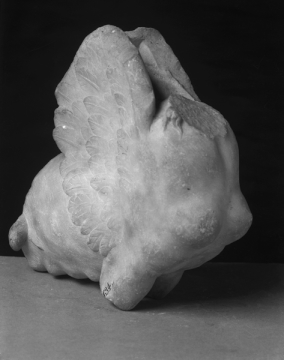Explore Collections


You are here:
CollectionsOnline
/
Fragment of a Roman table support: the body of a grecian sphinx
Browse
Curatorial note
Although the head is missing traces of the hair of this sphinx can be seen on the shoulders and traces of the tail on the right flank.
A large sphinx table support of identical design and technique in details, especially about the wings, is embedded at the foot of the pile of architectural fragments in the niche to the right of the entrance to the inner court of the Palazzo Farnese, Rome1. Since these include large fragments of the cornice, frieze (victories and trophies, foliate genii etc.) and architraves of the Domus Flavia, especially of the Aula Regia2, the Farnese sphinx fragment - of the same exceptionally fine quality as this Soane piece - may have come from the family excavations in the Orti Farnesiani. This Soane sphinx may have also formed part of a piece of sculptured furniture found in this area. An idea of the complete ensemble may be gained by an excellent though somewhat drier and consequently probably second century example, a table support in the Lateran Museum, Rome3. A rather novel but not unrelated use of the sphinx table support appears in an example drawn by L. Canina4 in which the table top is set on legs of conventional rectangular form at either end of the base, and beneath the centre appears a seated Sphinx from the area between whose wings springs an additional centre support.
The heads of these decorative sphinxes in the Graeco-Roman period were usually conceived in traditional Greek sculptural terms, copying sepulchral sphinxes like that in the Museum on the island of Aegina. Thus they were based on good classical prototypes going back to the middle of the fifth century BC.5 The same severe heads were used as ornaments on terminal shafts of balustrades, such as in the example found in fragments at the Odeion of Agrippa in the Athenian Agora and now reconstructed to show a section of the stage-front.6
1 J.M.C. Toynbee, The Hadrianic School: A Chapter in the History of Greek Art, Cambridge, 1934, pl. XXXVI, no.1.
2 P.H. Von Blankenhagen, Flavische Architektur und ihre Dekoration, Berlin, 1940, p. 65f.
3 P. Gusman, L'Art décoratif de Rome de la fin de la république au IV siècle, 2 vols, Paris, 1910, vol. II, pl. 103.
4 A. Speltz, Styles of Ornament from Prehistoric Times to the Middle of the Nineteenth Century, trans. and ed. R. P. Spiers, London and Leipzig, 1910, pl. 42, no. 6, also 2.
5 Compare Boston, M.E.A. no. 88.352: The Classical Journal 65, No. 2, 1969, pp. 52-53.
6 See J. Travlos, Pictorial Dictionary of Ancient Athens, New York, 1971, p. 375, fig. 487.
A large sphinx table support of identical design and technique in details, especially about the wings, is embedded at the foot of the pile of architectural fragments in the niche to the right of the entrance to the inner court of the Palazzo Farnese, Rome1. Since these include large fragments of the cornice, frieze (victories and trophies, foliate genii etc.) and architraves of the Domus Flavia, especially of the Aula Regia2, the Farnese sphinx fragment - of the same exceptionally fine quality as this Soane piece - may have come from the family excavations in the Orti Farnesiani. This Soane sphinx may have also formed part of a piece of sculptured furniture found in this area. An idea of the complete ensemble may be gained by an excellent though somewhat drier and consequently probably second century example, a table support in the Lateran Museum, Rome3. A rather novel but not unrelated use of the sphinx table support appears in an example drawn by L. Canina4 in which the table top is set on legs of conventional rectangular form at either end of the base, and beneath the centre appears a seated Sphinx from the area between whose wings springs an additional centre support.
The heads of these decorative sphinxes in the Graeco-Roman period were usually conceived in traditional Greek sculptural terms, copying sepulchral sphinxes like that in the Museum on the island of Aegina. Thus they were based on good classical prototypes going back to the middle of the fifth century BC.5 The same severe heads were used as ornaments on terminal shafts of balustrades, such as in the example found in fragments at the Odeion of Agrippa in the Athenian Agora and now reconstructed to show a section of the stage-front.6
1 J.M.C. Toynbee, The Hadrianic School: A Chapter in the History of Greek Art, Cambridge, 1934, pl. XXXVI, no.1.
2 P.H. Von Blankenhagen, Flavische Architektur und ihre Dekoration, Berlin, 1940, p. 65f.
3 P. Gusman, L'Art décoratif de Rome de la fin de la république au IV siècle, 2 vols, Paris, 1910, vol. II, pl. 103.
4 A. Speltz, Styles of Ornament from Prehistoric Times to the Middle of the Nineteenth Century, trans. and ed. R. P. Spiers, London and Leipzig, 1910, pl. 42, no. 6, also 2.
5 Compare Boston, M.E.A. no. 88.352: The Classical Journal 65, No. 2, 1969, pp. 52-53.
6 See J. Travlos, Pictorial Dictionary of Ancient Athens, New York, 1971, p. 375, fig. 487.
Rome; collected in Rome by Charles Heathcote Tatham for the architect Henry Holland during the 1790s. See Cornelius Vermeule, unpublished catalogue of the Antiquities at Sir John Soane's Museum, Introduction, transcription of Tatham letters, List 2, no. 48.
Literature
Tatham: Drawings, 2.
Soane collections online is being continually updated. If you wish to find out more or if you have any further information about this object please contact us: worksofart@soane.org.uk


